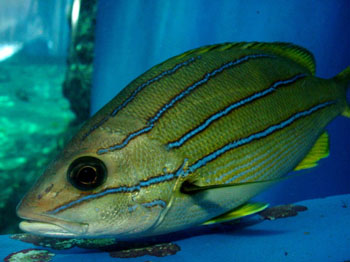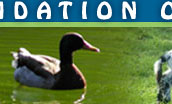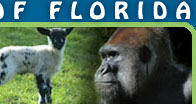Fishing
Sinking the Myths
Contrary to its proponents' claims, there is nothing sporting,
wholesome or conservationist about fishing.
Fish
Feel Pain Too!
Common sense, as well as scientific evidence, tells us that fish
experience pain. In fact, all vertebrates (animals with backbones),
whether they are cold or warm blooded, two or four footed, feathered
or with scales, feel pain and suffer from stress.
 Fish
have particularly sensitive mouths, which are important not only
for feeding, but also for building nests and for hiding their
offspring from danger. Fishing hooks tear apart their fragile
mouths. Swallowed hooks damage internal organs. Hooks can also
become caught in their gills or eyes.
Fish
have particularly sensitive mouths, which are important not only
for feeding, but also for building nests and for hiding their
offspring from danger. Fishing hooks tear apart their fragile
mouths. Swallowed hooks damage internal organs. Hooks can also
become caught in their gills or eyes.
In deep-sea fishing, the use of sharp metal hooks called “gaffs”
is quite common. Gaffs are impaled into the body of a fully-conscious
fish to make it easier to load the fish onto the boat.
Catch-and-Release
An increasingly popular form of fishing, where the fish is hooked,
"played" to exhaustion, and finally thrown back, is
known as “catch-and-release.” Proponents claim that
this is a “humane” form of fishing, but we strongly
disagree! Catch and release is a form of torture. Many of these
fish are released maimed, and doomed to a slow, painful death.
Mortality can result from swallowed hooks, careless handling resulting
in broken jaws or internal injuries, and stress or exhaustion
- conditions that can lead to death days after release. A previously-caught
fish who does manage to stay alive can often be identified by
the torn mouth and net marks on the body, wounds that often become
infected.
Simply removing
a fish from water is harmful. The stress caused by pressure and
temperature changes from pulling a fish up from deep water can
be fatal. Handling a fish, by hand or with a net, removes the
outer protective mucous barrier, leaving the fish open to infection.
Live
Bait
Live bait includes any living animal or parts of dead animals,
such as heads, eyes, or eggs that are fastened to a hook to induce
a fish to bite. Animals commonly used as live bait include frogs,
minnows and other small fish, slugs and insects. Frogs are hooked
through the leg or back and drowned. Minnows are pierced with
one or two hooks through the eye sockets, tail, lips, or back,
and are then cast into the water where they are eaten, or die
of their injuries.
Deadly
to Other Wildlife
Fish and animals used as bait are not the only casualties of fishing.
Lost and discarded fishing tackle - hooks, line, and "sinkers"
(weights) - is the leading cause of accidental injury and death
of sea birds, and contributes to the injury and death of other
wildlife as well. Birds pick up hooks and weights while feeding
and become entangled in the nearly-invisible fishing line. Pelicans,
egrets, herons, osprey, turtles, and manatees have all been found
with injuries from fishing tackle. Entanglement can lead to starvation,
or, if the line has cut off blood circulation in a foot or wing,
infection and eventually death.
Line can be
cut by the fish's teeth, get snagged on vegetation or rocks, or
just break under the strain caused by the fish struggling. The
result is lost line, with hooks and weights attached. Today's
fishing line is not easily biodegradable and remains a hazard
to wildlife for many years.
What
You Can Do:
Speak out against the killing of animals for sport, either in
face-to-face discussions or through letters to your newspaper.
Suggest that there are many outdoor activities one can enjoy without
causing pain and suffering to animals.
If your local
newspaper includes fishing in the sports section, write or call
and ask them to reconsider whether fishing is really a “sport.”
Remind them that “sports” normally involve willing
participants on both sides and, when done properly, all participants
live to play another day. (If it’s not a “sport”
when a shark kills a human, why is it a “sport” when
a human kills a shark?)
Join a beach
cleanup or collect fishing-related waste from your local river,
lake or canal.
Join ARFF!
Make your voice one of many.
Make a donation
to ARFF so that we may continue our fish-friendly education.








